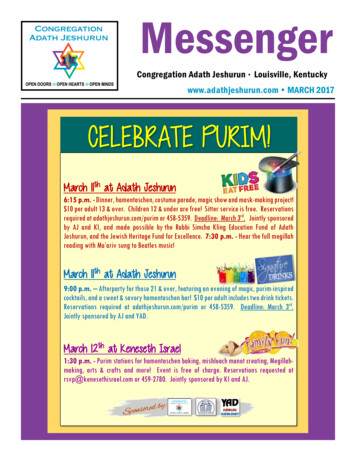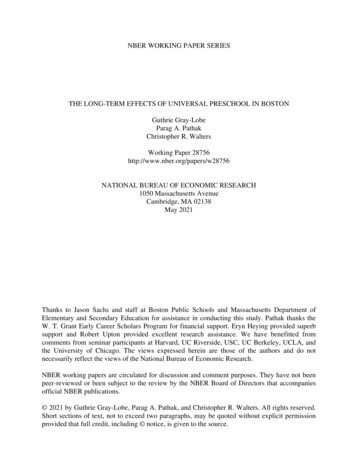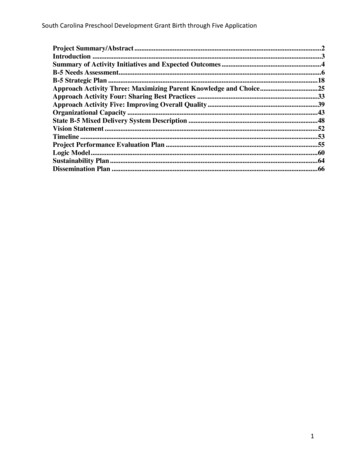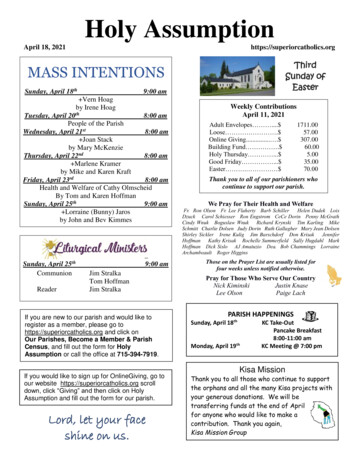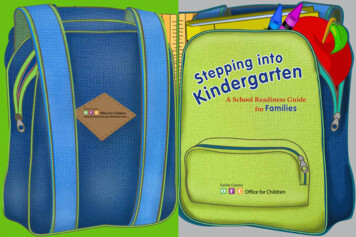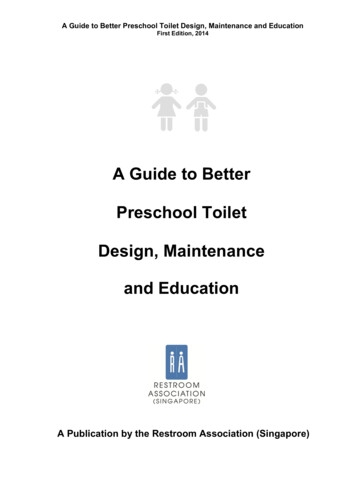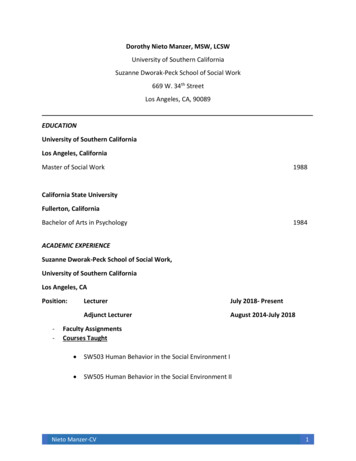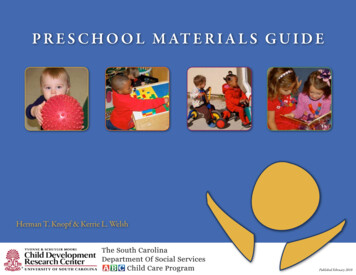
Transcription
P R E S C H O O L M AT E R I A L S G U I D EHerman T. Knopf & Kerrie L. WelshPublished February 2010
Table of ContentsIntroduction .1The Preschool Environment .3Learning Centers .4Block Center .7Dramatic Play Area .9Art Center .12Manipulatives Center .15Cozy Book/Library Center .17Science/Discovery Center .19Music and Movement Center .21Sand and Water Center .23Computer Centers .25Outdoor Play .27Notes .29References .30APPENDIX IThis document is meant to support the thoughtful selection ofequipment and materials as part of efforts to increase the qualityof childcare programming experienced by young children in SouthCarolina. The document is being field-tested to solicit feedback fromEarly Childhood Professionals from across the state. Please sendcomments and suggestions to the:USC Child Development Research Centercdrc@sc.edu (803) 777-2136
AcknowledgmentsSouth Carolina is appreciative of the American Recovery and Reinvestment Act (ARRA) funds that have made this initiative to upgradethe materials and equipment for South Carolina child care providers (centers, family homes, and group homes) a reality. The ARRA fundswere made available to the South Carolina Department of Social Services (SCDSS), administrator for the Child Care and DevelopmentFund (CCDF) under the leadership of Leigh W. Bolick. To assure the developmental appropriateness and quality of the Guide, SCDSSsought the early childhood leadership and management of the College of Education, University of South Carolina.This Preschool Materials Guide is designed to assist child care providers in selecting high quality materials for their classrooms, not onlyfor the ARRA funded grants in the short term, but also for long-term planning to help guide and prioritize future purchases. It is a toolthat can help make the most of current investments as well as those in the future.The Preschool Materials Guide is the result of careful consideration of South Carolina’s child care regulatory standards, the South CarolinaABC Child Care Program Standards, and the Environment Rating Scales (ERS) used at the different quality levels of the South CarolinaABC Child Care Program. The South Carolina Good Start Grow Smart Early Learning Standards were reviewed and incorporated as well.The Preschool Materials Guide was modeled after an ABC Child Care Program guide authored by the late Saundra V. Ground, M.Ed.Herman T. Knopf, Ph.D., and Kerrie L. Welsh, M.A., authors and editors of this guide, wish to thank Carol Perkins, M.Ed., Angela Baum,Ph.D, Nancy Freeman, Ph.D, Jillian Peltzman, Elyse Osborne, and Rebecca Horsey for their work in support of this document. Thanksare also given to Mac Brown, Ph.D who provided some of the photographs included in the guide.Review and comments by the following staff of the South Carolina ABC Child Care Program are greatly appreciated: Beverly B. Hunter,M.S.; Noelle P. McInerney, M.Ed.; Myrna S. Turner, M.Ed.; Cynthia P. Moyd, M.A.; Ginger Miller, and Melissa Heston.Reviews from Richard Knight and Bob Howard at South Carolina Child Care Licensing are also greatly appreciated.Graphic design by Michelle M. Moshinskie.
IntroductionThe choices for designing a quality childcare program for youngchildren can be overwhelming for a childcare professional, especiallywhen working with a limited budget. This guide has been created tohelp you to design a high-quality environment for young children,while making the best choices for your budget. While purchasing thecorrect materials is not sufficient supervision and interaction withinterested adults is necessary for children to make full use of them.Through intentional teaching, materials can be used for both childguided experiences and adult-guided experiences. Materials need tobe: interesting to children, sturdy, age appropriate, offer variety andchoice, and be arranged in such a way as to encourage independenceand creativity.How This Document is OrganizedIn this guide, we look at the whole classroom to identify and describebasic equipment and materials that should be in classrooms forpreschool aged children. The following sections of this guide providedescriptions of common learning centers found in early childhoodclassrooms. The description of each learning center includes thesefeatures:Development & LearningThis section describes the developmental domains that are likely to beaddressed as a result of child and teacher engagement in the center.Notes have been included to help you connect children’s learning ineach center with the South Carolina Good Start Grow Smart EarlyLearning Standards.Materials ListThis prioritized list includes the basic materials needed in thelearning center as well as accessories that will expand and extendchildren’s interest and discovery.Brand names are sometimes used to describe items but are not meantto be exclusive. Generic “copies” of those items may be acceptablewith the following precaution: materials should be durable enoughfor daily use by young exuberant learners.The Shopping ListIncluded at the end of this guide is a classroom inventory checklistthat can be used to help you create and prioritize your materialsand equipment shopping list. First you will use the list to conducta classroom inventory, identifying all of the items on the list thatyou currently have and their present condition (like new, good, inneed of repair). Then, review the list to determine if there are anymaterials that you either need to replace or add to your classroom.There are quantities listed for each item on the list. These are basedon a class size of 20 children. Use your professional judgment whendetermining the quantities of materials you will need based on thenumber of children enrolled in your class.FundamentalsWhile this document focuses on the materials and equipment thatshould be in the learning environment, they are no replacement forhigh quality teacher/child interaction. The way in which caregiversmake use of the items in their classrooms will have a significant impacton the overall quality of the learning experience for young children.1
Teacher/child interaction is the most important aspect of a highquality learning environment. Great teachers help children learn byobserving how children use materials and then talking to the childrenabout what they are doing to extend the learning experience. Theseintentional teachers work alongside children to ensure that materialsare used in healthy and safe ways while also making the learningexperience fun and educational.In addition to attending to how materials are used in the environmentit is the teacher’s responsibility to ensure that the learningenvironment is healthy and safe. Materials need to be kept clean toreduce the spread of illness, organized to facilitate meaningful childengagement and in good repair to reduce unnecessary frustrationor child injury. The few minutes teachers spend throughout the daymaking sure things are clean, neat, and orderly help teach children torespect the materials in the environment. If things are accidentallybroken or excessively worn, they should be immediately put aside forrepair, recycled, or trashed.wide passage ways through the classroom environment. In the casewhere a child may need specialized adaptive equipment to benefitfrom the general education curriculum (i.e. communication board,child positioning equipment, and/or specialized eating utensils) theteacher should contact and collaborate with the child’s caseworker orIEP coordinator.While it is far beyond the scope of this document to identify allpossible modifications that might be needed to meet an individualchild’s needs, it is important to recognize that each particular groupof children will be unique and thus will benefit from classroomcustomization to ensure that their needs are being met.Attending to Individual Child NeedsWhile this document will be helpful in identifying basic materialsand equipment that should be included in a classroom environmentfor children from three to five years of age, thoughtful planning willalso be necessary. All children have individual strengths, needs, andinterests and these should be taken into consideration when selectingand arranging materials in your classroom. When serving youngchildren with special needs, some environmental rearrangementmight be necessary to adequately accommodate an individual child’sneeds. For example, a child who is easily over stimulated by loudnoises might need an environment that includes sound-dampeningfurnishings. A child who uses a wheel chair to move around will need2
T H E P R E S C H O O L E N V I RO N M E N TGoing from an empty room to a fully operational preschool classroomrequires a vision and a plan. There are certain basic items requiredby either regulation or best practices or both, and there is a widerange of materials from which to choose. Considerations includedevelopmental appropriateness, alignment with state standards,environment rating scales, as well as your budget.The National Association for the Education of Young Children(NAEYC) reminds us that developmentally appropriate practiceshave three qualifiers: appropriate to the child, appropriate to thegroup, and appropriate to the culture. Therefore, there can be nostrict rule of thumb for what a well-equipped preschool classroomlooks like. However, there are guidelines that can help you design aclassroom to support the learning and play of young children.General Room Arrangement Guidelines: Classrooms should include a balance of areas for active play andareas for quiet play. Messy activity areas such as art, science, and meals should be nearwater access to aid in clean-up. The “Hand Washing” sink for toileting and diapering should beseparate from a sink used in food preparation. Furniture should be arranged to help reduce runways (tominimize children’s running in the classroom) while making it easyfor children to get around. Private spaces for one or two children (to allow for those timeswhen a child needs to “be by myself ” – not a Time Out space) Materials for children should be organized and stored to provideeasy access for children. All child accessible materials should be age appropriate, clean, andin good condition. Each child should have an area for storage of personal items. Materials not appropriate for children should be stored in a highand/or locked cabinet to prevent injury. Each classroom should include a Parent Communication Area toencourage parent/teacher communication. Each classroom should have at least five learning centers, one ofthem a cozy place.In addition to the above mentioned guidelines, preschool teachersshould also consider several key questions to make sure that the roomarrangement and selected materials are appropriate for the childrenand classroom: What are the dimensions of the room? Where are the windows and the doors? Where are the sinks and toilets? How many children will occupy this space? What are the ages of the children in this room?Dividing a classroom into learning centers is like dividing theclassroom into small rooms. Typically, low shelves are used toaccomplish this. Child sized shelves are needed in each center fortwo purposes: Define the center (serve as dividers between centers) Provide child accessible storage space for materialsWhen attempting to maximize the money that you are investinginto classroom materials it is important to consider multiple uses for3
furnishing. For example, the carpet for the block area can also be usedto hold group meetings. The tables used for meals and snacks can alsobe part of the art area. While reviewing each center and determininghow they will fit in your curriculum remember to remain open tomany uses for the materials listed.The following table outlines general use equipment (materials thatare not necessarily associated with a particular learning center) thatshould be included in an environment for young children.GENERAL USE FURNITUREQUANTITYAt least 220202011DESCRIPTION OF MATERIALSChild sized tables (so that seated children’selbows reach the tabletop)Child sized chairs (so that seated children’s feettouch the floor)CubbiesMats or cotsAdult chairLockable storage (for hazardous/toxic cleaningsupplies as well as materials not in current use,and teachers’ possessions)FAMILY COMMUNICATION CENTERThis area of the room provides a location for parents to leave andreceive messages and/or talk with a teacher as she/he comes and goes.Teachers who make a point of having pleasant interactions dailybuild a collaborative partnership with each child’s family. Teachersand parents use this area for sharing the children’s milestones andaccomplishments.This area is important for smooth transitions between home and thechildcare center. Important communication between families andteachers is easy with the use of a message center, which may includea bulletin board, a 3-ring binder or a basket of folders for individual/private messages. Displaying photos of the children at play or theirartwork can add to the welcoming atmosphere. If you place thefamily communication area across the room from the entry it maydraw parents into your classroom and encourage discussion andinvolvement in your program.LEARNING CENTER SWhen designing a developmentally appropriate curriculum forpreschool students, learning centers are a major consideration.Rooms are commonly divided into learning centers which provide fora variety of learning opportunities for children to maximize interestand engagement. Each child has an opportunity to solve problems, toexchange ideas with peers, and to learn appropriate social behaviors.Learning centers should provide opportunities for children to workat their own interest level and at their own pace. An effective teacheris ever-present to bring about individual learning through teacherguided interactions and activities. Most activities are typically childinitiated (the child decides which center to work in, how long,what materials he/she will use and what the activity will be) whilesome planned activities may require more teacher involvement totake advantage of teachable moments or develop interest amongchildren.4
While many of the materials in learning centers will remain consistentthroughout the year, some may be rotated regularly to maintain childinterest. Based on the planned curriculum, teachers may select specificactivities to support children’s learning. These should be plannedahead of time based on children’s interest and ability levels.Learning centers provide children with: Flexibility in the time spent on an activity Freedom to participate in a variety of self-selected activitiesCommon Learning CentersThere are several common learning centers often seen in preschoolprograms. The list below includes these learning centers and providesthe structure for the rest of this document. The size of your classroomand number of children enrolled will inform the number of centersyou might include. While there should be a minimum of five learningcenters, classrooms with more space ought to have as many centers aspossible to offer children a variety of self-selected activities.1. Blocks2. Dramatic Play3. Art4. Manipulatives5. Literacy/Books/Library6. Science/Discovery7. Music & Movement8. Sand & Water9. Computer10. Outdoor AreaWhen deciding which centers you will include, take care to addressthe needs of children identified below.Children should have: opportunities for independent and collaborative play opportunities for quiet play that is separated from active play opportunities to grow in all developmental domainsSupervising Learning CentersDuring center time, each child chooses a center to work in. Teachersshould set limits on the maximum number of children who maywork in a center at one time to avoid clusters of children gathering injust one or two learning centers. These limits should be based on thesize of the learning center and the amount of materials available inthat center. There should be more available spaces across centers thanthere are children enrolled in the classroom. This allows children tomove between centers without having to wait for another child tomove.To select a learning center activity, children need to know how manychildren are allowed in a center at a given time. This will require aplanned system that the children can manage and is likely to includesome form of visual aid. Posting a number at the entrance to the centerthat represents the maximum number of children allowed at one timeis one strategy to accomplish this. Another is to hang the numberof clothespins at the entrance to represent the number of childrenallowed in the center. As children enter the learning center they areinstructed to take a clothespin and clip it to their shirt. When all ofthe clothespins are used, the children know that the center is full.5
In a classroom where there is a teacherand an assistant, both are responsiblefor supporting children’s play andwork in the learning centers whilealso monitoring children andencouraging supportive friendshipbehaviors. In this setting, teachersmove from center to centerassisting where needed andobserving children at play to learn aboutindividual developmental progress, and to seek outopportunities to play with children to support growth and learning.When children are in the learning centers, the teacher’s role is to: Encourage children to share ideas and experiences with otherchildren as well as with the teacher. Engage children in conversation and by asking open endedquestions (questions that require more than just yes or no answers). Extend children’s learning by introducing new ideas andmaterials. Model pro-social behavior. Support children’s problem solving efforts. Observe children’s skills, development and interests. Record observations to use in planning and documentation.6
BLOCK CENTERDevelopment and Learning in the Block Center“When children construct, create and represent their experienceswith blocks, they grow in each area of development: Social/Emotional: Children negotiate for materials they wantto use, determine how many children can work in the area, care formaterials, and follow the rules for building safely. They also exchangeideas. Since one child’s idea of how to build a zoo, for instance, maydiffer from another’s, children expand their knowledge and learn torespect viewpoints different from their own. Physical: Children’s small muscles develop when they carry andcarefully place blocks together to form a bridge or make an intricatedesign. They gain strength in their large muscles using hollow blocks,and improve eye-hand coordination when they carefully balanceblocks so they won’t tumble. Cognitive: As children experience the world around them, theyform mental pictures of what they see. Playing with blocks givesthem an opportunity to recreate these pictures in concrete form.The ability to create these representations of their experiences is thebasis for abstract thinking. Moreover, block play promotes a concreteunderstanding of concepts essential to logical thinking. Childrenlearn about sizes, shapes, numbers, order, area, length, patterns,and weight as they select, build with, and put away blocks.They increase their vocabularies when adults give them new wordsto describe what they are doing, and develop their writing skills bymaking signs for their buildings.”(Dodge 2002, p. 243)The intentional teacher will recognize the value of block playto meet Good Start Grow Smart Guidelines: APPROACHESTO LEARNING 1–5, SOCIAL AND EMOTIONALDEVELOPMENT 1–4, MATHEMATICS 1–5, LANGUAGE &LITERACY 5, PHYSICAL DEVELOPMENT & HEALTH 1 &2. Through her/his open-ended questions, “I wonder. . .” statements,and/or suggestions, as well as the timely addition of materials, ateacher can guide a child to make his or her own discoveries andconnections as he/she builds.Considerations for Block PlayIt is important to have a sufficient quantity of blocks (200-300) invarious sizes to allow for three or more children to build. Carpethelps to muffle the crash of blocks falling.You may find it helpful with younger children to begin the year withonly a few shapes from the set (half-unit or square, unit, and doubleunit, perhaps triangles) and add additional shapes over the first fewweeks of school. This will allow you to teach the sorting process atcleanup time that allows the children to put the blocks away neatly. Language: Children are very willing to talk about theirconstructions when adults ask questions and show genuine interest.7
Block Play Accessories/EnhancementsBecause block play provides children with an opportunity for creativeand imaginative play, it is helpful to present a wide assortmentof accessories and enhancements to support and/or prompt thiscreativity. Adding or replacing accessories throughout the yearprovides additional challenges to children that promote learningand development, particularly if you include items that reflectchildren’s interests and/or community events (e.g., road constructionequipment). Particular classroom themes can also be reflected in theaccessories and enhancements you provide.As additional items are included, an additional shelf may be required.Sturdy containers to keep materials organized facilitate clean-up, asdo shelves labeled with pictures and words. It is recommended thatyou rotate these sets of figures, animals, signs, and vehicles. Avoidkeeping too many materials in the block center at the same time asthis may be over stimulating for children and limit your ability tointroduce novelty. Be sure to include materials that are appropriatefor your community (i.e. things that children often see in the worldaround them).BLOCK CENTERQUANTITYFURNITUREAs neededStorage shelfAs neededContainers for materials1Carpet – solid color and tight weaveMATERIALS TO SUPPORT LEARNING1 set (200300 blocks ofUnit blocks (hardwood)various shapesand sizes)1 setFamily figures (multi-ethnic) (6-8 figures)Community workers or career people (multi1 setethnic) (6-8 figures)1 setPeople with physical impairments (6-8 figures)1 setCars (4-6 cars)1 setTrucks (4-6 trucks)Specialized blocks (tabletop blocks, door &2 setswindow blocks, colored blocks, etc.)Animals (jungle, forest, domesticated, farm,3 or 4 setsaquatic): large and/or small1 setCommunity vehicles (4-6 vehicles)1 setTraffic signs1 setDinosaurs (4-10)1 setWooden train & trackSpecialized blocks (large hollow blocks, see1 setthrough blocks)8
D R A M AT I C P L AY A R E ADevelopment and Learning in the Dramatic Play Area“When children engage in dramatic play they deepen theirunderstanding of the world and develop skills that will serve themthroughout their lives: Social/Emotional: To engage in dramatic play with others,children have to negotiate roles, agree on a topic, and cooperate toportray different situations. They recreate life experiences and try tocope with their fears by acting out roles and situations that worrythem. For example, a child who anticipates going to the hospital foran operation can pretend to be the doctor. By assuming this role,the child can switch from feeling out of control to being in charge.Research shows that children who engage in dramatic play tend todemonstrate more empathy toward others because they have triedout being someone else for a while. They have the skills to cooperatewith peers, control impulses, and are less aggressive than childrenwho do not engage in this type of play. Physical: Children develop small muscle skills when they buttonand snap dress-up clothes and dress the dolls. They practice hand-eyecoordination and visual discriminations skills when they put awayprops and materials. Cognitive: When they pretend, children create pictures in theirminds about past experiences and the situations they imagine. Theseimages are a form of abstract thinking. When children set the tablefor a meal for two or use play money to purchase food at their grocerystore, they explore math concepts. They also learn from one anotheras they share ideas and solve problems together. Language: To engage with others in dramatic play, childrenuse language to explain what they are doing and ask and answerquestions. They choose the language that fits the role they haveselected. They use reading and writing skills when literacy props areincluded in the Dramatic Play Area.”(Dodge, 2002, p. 271)Considerations for the Dramatic Play CenterStandard practice in early childhood classrooms is to providechildren the opportunity to reenact real life experiences, beginningwith their home. Therefore, equipment and materials for pretendingto be mommy and daddy are among the first things to include. Propboxes to facilitate other pretend play (such as doctor, grocery store,and firefighter) can be rotated according to the children’s interests.Alternative sources of dress-up clothes and pretend food containerswill stretch the budget while still providing items to spur imaginationand creativity. Clothing slightly large for preschoolers can be donatedor found at places such as Goodwill; it will not be as difficult to put onas adult sized clothes. Empty food-packages (e.g. rice boxes, oatmealcontainers, and cereal boxes) carefully opened and re-taped providefamiliar environmental print that facilitates literacy development.The items selected should promote healthy food choices. As youconsider real life items to be included in the dramatic play area makesure that the items are safe for children.9
Dramatic Play Accessories/EnhancementsDramatic play is limited only by your imagination and that of thechildren in the class. It can be re-equipped as often as children’sinterests change, while keeping the original materials available. Justas in blocks, all of the scenarios are not made available at the sametime, but stored in separate theme-related bins commonly referredto as prop-boxes. Often, materials supplied in the dramatic play areareflect classroom themes or allow children to re-create events intheir lives (e.g. a fire in the community would prompt a great deal offirefighter play).Materials in prop boxes are collected over time and often consist ofrecycled items. For example, an old thick rope makes an acceptablefire hose and raincoats can be fire coats. Fire companies often giveaway children’s fire hats which you can keep in your prop box. Parentscan also be sources of items for prop boxes or material on loan for theduration of a particular play theme.typewriter, stamp pads, paper clips, telephone, envelopes, file folders,scissors, tape Post Office: envelopes, junk mail, small boxes for packages,stamps/stickers, shoulder bags, play money, rubber stamps, shoeboxes for mail boxes, paper/index cards, hat Doctor/Nurse: white/pastel shirts for uniforms, paper andclipboard, band-aids, cotton balls, empty small bottles, scale, tapemeasure or height chart, flashlight, blankets, tongue depressors/popsicle sticks, tape, cloth or elastic for bandagesReading material found in the home can be replicated in thedramatic play area, including newspapers and magazines in additionto children’s books, especially when a living room area is added.Prop-Box Collection Examples: Zoo: stuffed animals, empty pet food boxes, pet toys, food bowls,boxes cut to resemble cages, child-sized broom, animal books Grocery Store: calculator/cash register, bags/sacks, empty foodcontainers (boxes and cans) coupons, play money, signs/newspaperads, plastic food, baskets Fire Station: raincoats, boots, rubber hose (thick rope or pieces ofold garden hose), hats, telephone, wagon Shoe Store: lots of shoes of various sizes and types, shoe boxes,play money, rules, purses, socks, sacks, cash register/calculator, smallstool, mirror, footies ( feet of panty hose) Office: paper, pens, stapler, calculator, tote bags/briefcase,10
DRAMATIC PLAY CENTER1 setQUANTITYFURNITUREKitchen set – either 4 separate pieces which will1also set off the area, or a one-piece unit1 setSmall table & chairs (table & 4 chairs)1Wooden rocking chair (child-size)As neededStorage shelvesAs neededContainers to keep materials organized1-2Child-size sofa and/or chair(s)MATERIALS TO SUPPORT LEARNINGMulti-ethnic dolls (w/removable clothing or2 ea. genderdiapers, bibs, & bottles as appropriate)1Doll bed & bedding (at least 1 blanket)Dishes (1 place setting for each child allowed in1 setthe center)Plastic flatware (1 place setting for each child1 setallowed in the center)Pots & pans (one large pot, one small pot, one1 setfrying pan)1 setCooking utensils (4-5 pieces)1Mirror (un-breakable)1 setPretend food5Dress-up items1-2Phones1Pretend iron & ironing board (child-size)1Doll high chair1Child-size sofa and/or chair(s)Several3-5House cleaning tools (e.g., broom, dust pan,brush, vacuum, mop, duster)Prop boxes developed around scenarios: grocerystore, office, hospital, pet store/veterinarian,firefighter, post office/mail carr
This Preschool Materials Guide is designed to assist child care providers in selecting high quality materials for their classrooms, not only for the ARRA funded grants in the short term, but also for long-term planning to help gui
